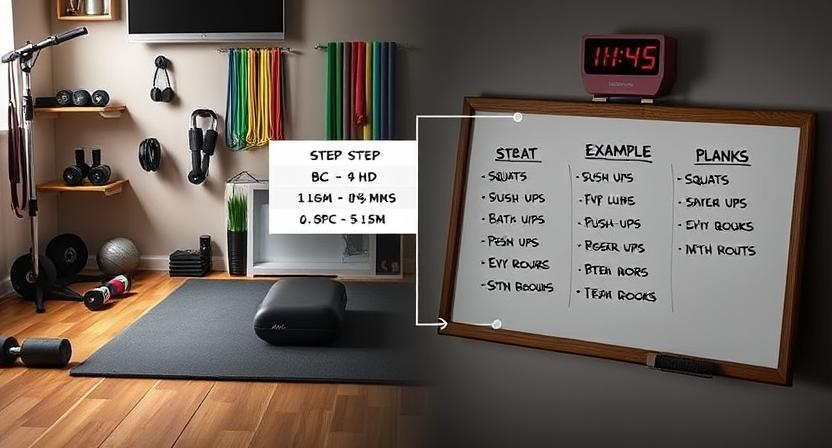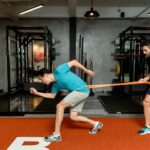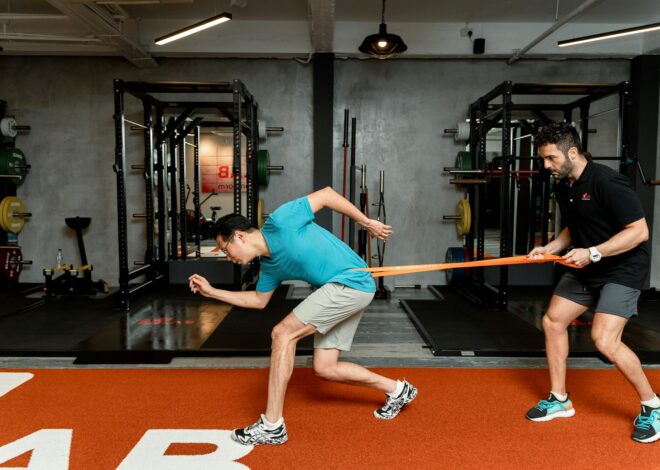
How to Build a Full-Body Strength Training Routine at Home
Benefits of Full-Body Strength Training

Full-body strength training offers a range of benefits that extend beyond just building muscles. By engaging multiple muscle groups simultaneously, this type of workout provides a comprehensive approach to improving overall strength, endurance, and stability. Additionally, incorporating full-body exercises into your routine can increase calorie burn, making it an efficient choice for those looking to optimize their time spent exercising.
Another advantage of full-body strength training is its ability to enhance functional movements that are essential for everyday activities. By targeting various muscle groups in coordination, individuals can improve their posture, balance, and coordination, which can translate into better performance in both athletic endeavors and daily tasks. Furthermore, the compound nature of many full-body exercises promotes joint stability and mobility, contributing to a reduced risk of injuries and improved long-term joint health.
Understanding the Importance of Strength Training
Strength training is an essential component of overall fitness that offers a multitude of benefits. It not only helps in building muscle strength and endurance but also plays a significant role in improving bone density, joint health, and overall function. Additionally, incorporating strength training into your workout routine can boost your metabolism, aiding in weight management and promoting a leaner body composition.
Engaging in regular strength training sessions can also enhance your athletic performance by increasing power, speed, and agility. It can improve your posture and stability, reducing the risk of injuries in daily activities and sports. Moreover, strength training has been shown to have a positive impact on mental health, reducing stress and anxiety levels while promoting a sense of accomplishment and confidence.
Identifying Your Fitness Goals
To begin your fitness journey effectively, it is crucial to clearly define your fitness goals. Whether you aim to build muscle, improve endurance, lose weight, or enhance overall health, setting specific and realistic targets will provide you with direction and motivation. Take some time to reflect on what you hope to achieve through your workouts and establish measurable objectives that can guide your training regimen.
Consider factors such as your current fitness level, time commitment, and personal preferences when determining your fitness goals. By tailoring your objectives to align with your capabilities and interests, you can create a plan that is both challenging and sustainable. Additionally, breaking down larger goals into smaller milestones can help you stay motivated and track your progress along the way.
Choosing the Right Equipment for Home Workouts
When setting up a home gym for your workouts, it’s essential to select the right equipment that will aid in achieving your fitness goals effectively. Consider the space available and opt for versatile pieces that can target multiple muscle groups. Dumbbells are a versatile choice as they can be used for various exercises such as squats, lunges, and shoulder presses. Additionally, resistance bands are great for adding intensity to bodyweight exercises or for targeting smaller muscle groups.
Another valuable piece of equipment to consider for home workouts is an exercise mat. Whether you’re performing yoga, Pilates, or floor exercises, a high-quality mat can provide cushioning and support to prevent discomfort or injuries. It’s also worth investing in adjustable kettlebells or a stability ball to further diversify your workouts and challenge your body in different ways. Prioritize equipment that aligns with your fitness objectives and allows for progressive overload to continue challenging your muscles as you grow stronger.
Creating a Balanced Exercise Routine
It is essential to incorporate a variety of exercises into your workout routine to ensure holistic fitness development. By including a mix of strength training, cardiovascular exercises, and flexibility work, you can target different aspects of your physical fitness. Strength training helps build muscle mass and improves overall strength, while cardiovascular activities enhance heart health and endurance. Flexibility exercises, such as yoga or stretching routines, can help improve mobility and prevent injuries.
When creating a balanced exercise routine, it is important to consider your individual fitness goals and preferences. Tailoring your workouts to align with what you enjoy and what you want to achieve can help you stay motivated and consistent. Additionally, mixing up your routine can prevent boredom and plateaus in progress, keeping your body challenged and continuously improving. By diversifying your exercises and focusing on overall well-being, you can promote a well-rounded approach to fitness that supports your long-term health goals.
Incorporating Compound Movements for Efficiency

Compound movements involve multiple joints and muscle groups working together in a single exercise, making them highly efficient for strength training. Examples of compound movements include squats, deadlifts, bench presses, and pull-ups. By incorporating these exercises into your workout routine, you can maximize your time and effort in the gym while targeting multiple muscle groups simultaneously.
Not only do compound movements improve overall muscle strength and coordination, but they also help enhance functional movements that are essential for everyday activities. These exercises mimic natural body movements, making them more practical and beneficial for real-life applications. Incorporating compound movements into your workout regimen can lead to more balanced muscle development and improved fitness performance over time.
Targeting Different Muscle Groups
When it comes to strength training, it’s important to target different muscle groups to ensure a balanced and effective workout routine. By focusing on specific muscles during your training sessions, you can improve overall muscle strength, endurance, and functional fitness. Targeting different muscle groups also helps prevent muscle imbalances and reduces the risk of overuse injuries.
To effectively target different muscle groups, it’s essential to incorporate a variety of exercises into your workout routine. For example, including exercises that target the chest, back, shoulders, arms, core, and lower body can help you work all major muscle groups. By varying your exercises and the equipment you use, you can engage different muscles and keep your workouts challenging and engaging. Remember to include both compound movements that work multiple muscle groups simultaneously and isolation exercises that target specific muscles for a well-rounded strength training program.
Implementing Progressive Overload for Results
Progressive overload is a fundamental principle in strength training that involves gradually increasing the challenge to your muscles over time. By progressively increasing the weight, reps, or sets in your workouts, you prompt your muscles to adapt and grow stronger. This approach is crucial for continuous improvement and preventing plateaus in your fitness journey.
To effectively implement progressive overload, it’s essential to keep track of your workouts and consistently push yourself to do slightly more each time. Whether it’s adding a few extra pounds to your lifts or aiming for one more rep than your previous session, small increments in intensity create the stimulus your body needs to progress. Remember, the key is gradual progression to avoid injuries and allow your muscles to adapt and become stronger over time.
Including Cardiovascular Exercises for Overall Fitness
Cardiovascular exercises play a crucial role in enhancing overall fitness levels. These activities, such as running, cycling, or swimming, are effective in improving heart health and increasing stamina. By incorporating cardiovascular exercises into your workout routine, you can boost your endurance, burn calories, and elevate your mood through the release of endorphins. Aim to engage in at least 150 minutes of moderate-intensity cardio each week to experience the benefits of improved cardiovascular fitness.
In addition to the physical benefits, cardiovascular exercises also contribute to mental well-being. Regular participation in aerobic activities has been linked to reduced stress levels and improved cognitive function. Furthermore, engaging in cardiovascular exercises can help with weight management and enhance your body’s ability to utilize oxygen more efficiently. Prioritize cardiovascular workouts as part of your exercise regimen to achieve a well-rounded approach to overall fitness and well-being.
Incorporating Flexibility and Mobility Work
To enhance your overall fitness and prevent injuries, incorporating flexibility and mobility work into your exercise routine is crucial. Stretching exercises can help improve your range of motion and muscle flexibility, allowing you to move more freely during workouts. Additionally, mobility exercises focus on enhancing joint function and stability, which are essential for performing exercises correctly and reducing the risk of overuse injuries.
Dedicate time before and after your strength training sessions to incorporate dynamic stretching and mobility drills. Dynamic stretching involves moving through a range of motions to activate muscles and increase blood flow, preparing your body for the upcoming workout. Mobility drills target specific joints and muscle groups to improve their function and help you move more efficiently. By including these elements in your routine, you can enhance your performance, reduce the risk of injuries, and promote better overall movement patterns.
Planning Your Training Schedule

When planning your training schedule, it’s crucial to consider your availability, preferences, and fitness goals. Setting aside dedicated time for workouts ensures consistency and helps you stay on track towards achieving your desired results. Whether you prefer morning sweat sessions or evening workouts, establishing a routine that fits into your daily life will increase the likelihood of adherence to your exercise plan.
It’s also essential to vary your workouts throughout the week to prevent overtraining and promote overall fitness. Incorporating a mix of strength training, cardiovascular exercises, and flexibility work can help you build a well-rounded fitness regimen. Additionally, scheduling rest days in between intense sessions is vital for muscle recovery and injury prevention. Finding a balance between challenging workouts and adequate rest is key to maximizing the benefits of your training program.
Setting Realistic Expectations
When embarking on a strength training journey, it is crucial to set realistic expectations to ensure sustainable progress and prevent feelings of discouragement. Understand that noticeable changes in strength and muscle definition may take time to manifest, as consistent effort and dedication are key factors in achieving fitness goals. Strive for incremental improvements rather than immediate transformations, recognizing that slow and steady progress is more likely to yield long-lasting results.
It’s important to remember that everyone’s fitness journey is unique, and comparing your progress to others can hinder your own growth. Focus on your personal goals and celebrate the small victories along the way, acknowledging the effort you put in rather than solely fixating on the end results. By setting achievable milestones and remaining patient with your development, you’ll foster a positive mindset that sustains your motivation for the long haul.
• Understand that progress takes time and consistency
• Strive for incremental improvements rather than immediate transformations
• Avoid comparing your journey to others
• Celebrate small victories along the way
• Set achievable milestones and be patient with your development
Listening to Your Body and Resting as Needed
It is crucial to pay attention to your body’s signals during your strength training journey. Your body has a way of communicating its needs, whether through feelings of soreness, fatigue, or discomfort. Ignoring these signals can lead to overtraining, injuries, or burnout. Therefore, it is important to listen to your body and rest as needed. Resting allows your muscles to recover and repair, ultimately contributing to improved performance and progress in your fitness goals. Remember that rest is just as important as the workout itself in achieving long-term success in your training regimen. So, be mindful of any signs of fatigue or strain and give your body the rest it requires to stay strong and healthy.
Adjusting Your Routine as You Progress
As you continue with your strength training journey, it is important to acknowledge that progress is a key component of any fitness routine. As your body adapts to the exercises you are performing, it is crucial to adjust your routine to keep challenging yourself and avoid hitting plateaus. One way to do this is by progressively increasing the intensity of your workouts. This can be done by adding more weight, increasing the number of repetitions or sets, or incorporating more challenging variations of the exercises you are already familiar with.
Additionally, listening to your body is essential when adjusting your routine as you progress. Pay attention to how your body responds to different exercises and intensities. If you experience persistent fatigue, soreness, or lack of progress, it may be a sign that you need to make changes to your routine. It is also important to celebrate your achievements along the way, no matter how small they may seem. This positive reinforcement can help you stay motivated and committed to your fitness goals.
Tracking Your Progress and Celebrating Achievements
As you proceed with your strength training journey, it is essential to keep track of your progress in order to stay motivated and continue pushing towards your fitness goals. By monitoring variables such as the weights lifted, the number of repetitions performed, and the improvements in your overall strength and endurance, you can gauge your advancement over time. Tracking your progress also allows you to identify areas that may need adjustment in your workout routine, enabling you to make necessary changes for continued growth and development.
Celebrating your achievements, no matter how big or small, is a vital aspect of maintaining motivation and staying dedicated to your fitness regimen. Whether you reach a new personal record in your lifting abilities, complete a challenging workout with greater ease, or notice positive changes in your physique and overall well-being, taking the time to acknowledge and appreciate your accomplishments is key to fostering a positive mindset. By recognizing and celebrating your successes, you reinforce your commitment to your fitness journey and inspire yourself to keep striving towards your fitness aspirations.
Staying Consistent with Your Workouts
Consistency is key when it comes to achieving your fitness goals. By making exercise a regular part of your routine, you are more likely to see progress and improvements in your strength and overall health. Establishing a set schedule for your workouts can help you stay on track and maintain momentum. Whether you prefer early morning sessions before work or evening workouts to wind down from the day, finding a time that works best for you and sticking to it can help create a sense of routine and discipline.
It’s important to treat your workouts like any other commitment in your life. Prioritize your exercise sessions and make them non-negotiable, just like you would with a work meeting or important appointment. By viewing your workouts as essential self-care time, you are more likely to stay consistent and dedicated to your fitness journey. Remember that progress takes time, and staying consistent with your workouts will ultimately lead to the results you desire.
Seeking Professional Guidance if Necessary

For individuals who are new to strength training or those who are looking to take their fitness journey to the next level, seeking professional guidance can be highly beneficial. A certified personal trainer or fitness coach can provide valuable expertise in designing personalized workout plans, ensuring proper form during exercises, and offering guidance on nutrition and recovery strategies. Their knowledge and experience can help you avoid injuries, plateaus, and wasted efforts, leading to more effective and efficient progress towards your fitness goals.
Professional guidance can also offer motivation, accountability, and support throughout your fitness journey. Working with a qualified fitness professional can help you stay focused, committed, and on track towards achieving your desired results. They can assist in adjusting your workout routine based on your progress, preferences, and limitations, ensuring that you continue to challenge yourself and make steady advancements in your strength, endurance, and overall fitness levels.
Avoiding Common Mistakes in Strength Training
One common mistake to avoid in strength training is neglecting proper form. Incorrect form not only decreases the effectiveness of the exercise but also increases the risk of injury. It’s essential to prioritize maintaining good form throughout your workouts, even if it means using lighter weights or performing fewer repetitions.
Another mistake to steer clear of is overtraining. While consistency is key in strength training, pushing yourself too hard without allowing for adequate rest can lead to burnout and potential injuries. Listen to your body’s signals and give yourself time to recover between intense workouts to optimize your progress and prevent setbacks in your fitness journey.
Incorporating Recovery Techniques for Optimal Results
Rest and recovery are essential components of any effective training program. After intense workouts, the body needs time to repair and regenerate muscle tissue. This is where recovery techniques come into play, helping to optimize your results and prevent injuries. Incorporating strategies such as foam rolling, stretching, and adequate sleep can aid in reducing muscle soreness and improving overall performance.
In addition to physical methods, mental relaxation techniques can also support recovery. Practices like meditation, deep breathing exercises, and mindfulness can help decrease stress levels and promote faster healing. By including these holistic approaches in your routine, you can ensure that your body and mind are adequately taken care of for optimal results in your fitness journey.
Maintaining a Healthy Diet to Support Your Training
To optimize the results of your training regimen, maintaining a healthy diet is crucial. The food you consume plays a significant role in fueling your workouts and aiding in muscle recovery. Focus on incorporating a balanced mix of lean proteins, complex carbohydrates, healthy fats, and a variety of fruits and vegetables into your meals. These nutrients provide the energy needed for your workouts while supporting muscle repair and growth.
Hydration is also key in maintaining a healthy diet for your training. Drinking an adequate amount of water throughout the day helps in regulating body temperature, lubricating joints, and transporting nutrients to cells. Aim to drink at least 8-10 glasses of water daily, and consider hydrating with electrolyte-rich beverages during intense workouts to replenish lost minerals. Remember to listen to your body’s signals for hunger and thirst, and fuel it with nutrient-dense foods to optimize your performance and recovery.












